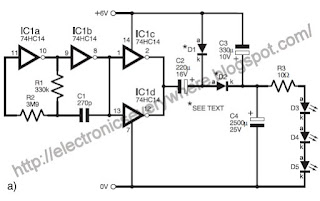THE high forward voltage of l.e.d.s is a challenge for efficient battery use. In the circuit shown in Fig.1a, a 74HC14 inverter is used to “double” the voltage of a 6V rechargeable ex-mobile-phone battery and drive a string of three 5mm l.e.d.s. The oscillator around IC1a and IC1b generates a square wave at about 2·8kHz, and its output is buffered by IC1c and IC1d used in parallel to maximise current to the doubler.
Booster
Using a 6V supply and with 1N4148 diodes in the rectifier, which comprises D1 and D2 plus capacitors C2 to C4, results in a rectified voltage of 9·6V having a 12mA output capability for a 24mA supply current – an electrical efficiency of over 80%. Using a 6·3V battery the output voltage is 10V and the available current increases to 16mA.
Using a 6V supply and with 1N4148 diodes in the rectifier, which comprises D1 and D2 plus capacitors C2 to C4, results in a rectified voltage of 9·6V having a 12mA output capability for a 24mA supply current – an electrical efficiency of over 80%. Using a 6·3V battery the output voltage is 10V and the available current increases to 16mA.
If Schottky diodes are used for D1 and D2, there is an increase in voltage of 100mV, resulting in a 20% increase in available current, to 19mA (6·3V supply), at similar efficiency, and a much brighter light. Using these diodes there might be benefit in increasing the oscillator frequency substantially. This is set by the values of R1 and C1.
At night, the torch casts a pool of white light two metres wide to a range of over 6m without a reflector, perfect to walk by. Side leakage is useful but seal the l.e.d.s at the rear as back-scatter is irritating. Nearby colours are vibrant compared with the gloomy monochrome of incandescent torches.
Pulsed Light
Anecdotal evidence suggests that a subjectively brighter light is obtained by low-frequency pulsing the l.e.d.s at currents higher than their continuous rating. There are two spare inverters, IC1e and IC1f, which can be wired as shown in Fig.1b. They provide variable-duty voltage pulses which directly drive a logic-level MOSFET and the string of three l.e.d.s, D7 to D9, via current limiting resistor R8.
With resistor R7 and potentiometer VR1 setting a total resistance of 3·9M , the frequency is 15Hz at 20% duty cycle. At 3mdistance from the subject the illumination appears continuous, but closer in the flicker is very obvious, like a strobe. Negotiating confined spaces, e.g. a spiral staircase, by this light is a challenge as the walls move as you climb. The output voltage is about 10·8V with a 0·8V ripple at the pulse frequency. The output current is limited by the inefficiency of the doubler.
Increasing the frequency to 35Hz (R7 + VR1 = 1·6M ) results in 35Hz, producing a good light, even to read by, though some flicker can still be seen as the duty cycle is 30%. Average current consumption is 21mA at 6·3V, with an l.e.d. current about 28mA.
Right Choice
In this application, 40106 or 74C14 CMOS chips are so markedly inferior to the 74HC14 that they are unsuitable. The published maximum voltage rating of an 74HC14 is 7·0V. The high initial voltage of a freshly charged battery may be tamed to within this limit by switching in a diode (e.g. 1N4001) until the terminal voltage has fallen somewhat.
In this application, 40106 or 74C14 CMOS chips are so markedly inferior to the 74HC14 that they are unsuitable. The published maximum voltage rating of an 74HC14 is 7·0V. The high initial voltage of a freshly charged battery may be tamed to within this limit by switching in a diode (e.g. 1N4001) until the terminal voltage has fallen somewhat.


No comments:
Post a Comment